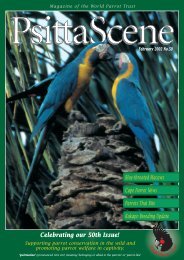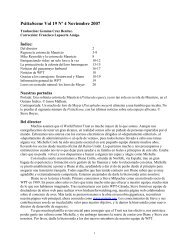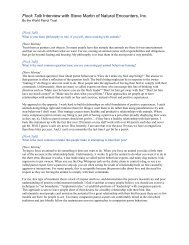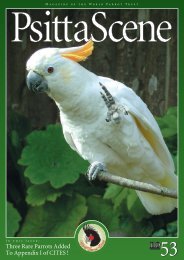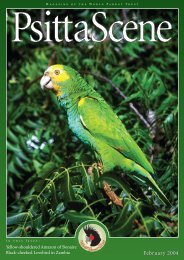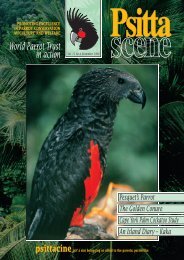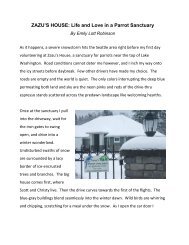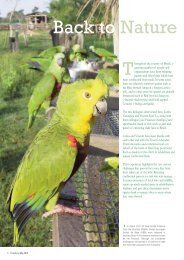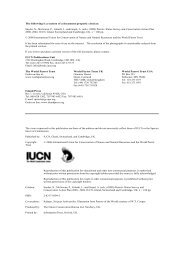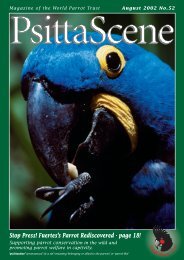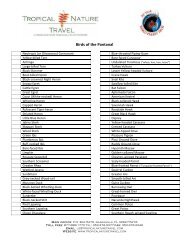PS 20 1 Feb 08.qxd - World Parrot Trust
PS 20 1 Feb 08.qxd - World Parrot Trust
PS 20 1 Feb 08.qxd - World Parrot Trust
You also want an ePaper? Increase the reach of your titles
YUMPU automatically turns print PDFs into web optimized ePapers that Google loves.
to seek veterinary advice first. All the<br />
behavioural intervention in the world won't help<br />
a parrot that is physically ill. As you have sought<br />
veterinary advice and have been advised that the<br />
problem is behavioural, let's focus on the key<br />
general areas that you can start considering.<br />
Diet & Foraging<br />
Scientific studies have demonstrated a significant<br />
disparity between wild and captive parrots in the<br />
time spent actively engaged in foraging and<br />
feeding behaviours. Reduced active foraging can<br />
be considered a precursor to "boredom" or lack<br />
of activity. This activity deficit has been linked to<br />
excessive amounts of time spent preening by<br />
captive parrots, which of course has been linked<br />
to improper care of feathers over time. The<br />
more dynamic, variable and creative you can be<br />
in presenting food, the longer the parrot will<br />
need to spend "foraging." This strategy has been<br />
used for decades in the zoo industry to reduce<br />
stereotypical behaviours in a range of animal<br />
species. The relevance for our companion<br />
parrots should be obvious.<br />
Diet management involves more than just<br />
withholding favoured foods for training treats.<br />
Creative diet management for parrots focuses on<br />
a range of goals. Initially, it is beneficial to<br />
establish a formulated diet as the daily base for<br />
food consumption. Then supplement this with a<br />
range of other food types, including fruit,<br />
vegetables, seeds, natural foliages and even live<br />
foods such as mealworms. The composition ratio<br />
of each of these supplements should be<br />
considered at a species-specific level. Not only<br />
will a diet based on a formulated food provide<br />
sound nutrition whilst minimising fat intake, it<br />
will also enhance the parrot's motivation to<br />
forage for more palatable items such as nuts and<br />
seeds.<br />
You have described a good diet for your African<br />
Greys. However, we often stop at ensuring all<br />
nutritional bases are covered, without taking the<br />
next step and considering the "when" and "how"<br />
of delivering the food. Ideally, time spent<br />
feeding (a behaviour that is incompatible with<br />
sitting around picking at feathers) is maximised.<br />
This may be particularly important at times<br />
when we are not around to provide the<br />
alternative stimuli needed to redirect feather<br />
picking behaviour.<br />
Diet management therefore extends to catering<br />
for food allocation at various times of the day.<br />
Most parrot species do not feed for only an<br />
hour in the morning and an hour in the<br />
afternoon as some articles claim. Feeding<br />
durations of up to 8 hours and at all times of<br />
the day have been observed in the wild.<br />
Therefore we may need to consider catering for<br />
the natural tendency to forage outside of an<br />
established captive feeding regime. From your<br />
description, you may have the ability to feed<br />
Peaches and Vincent around those times when<br />
you leave the house. By doing this you are<br />
introducing a stimulus that is likely to offer a<br />
highly motivating alternative to feather picking<br />
when you are absent.<br />
In my experience, creative food delivery still has<br />
limitations in the remediation of feather picking.<br />
Best results for providing alternatives to chewing<br />
on feathers are usually derived from the<br />
provision of natural foraging "browse". This<br />
requires a species-specific understanding of<br />
parrots and an appreciation of the huge<br />
variability in foraging behaviours and<br />
preferences. What works as a foraging motivator<br />
Photo: © Arlene Alpar<br />
Great ideas such as delivering food in foraging toys<br />
rather than open bowls can reduce boredom and<br />
feather picking behaviour.<br />
Photo: © Jim McKendry<br />
Providing natural foraging browse, such as the<br />
Allocasuarina cones eagerly taken by this Gang-<br />
Gang Cockatoo, offers the most effective redirection<br />
for feather chewing behaviour for many species.<br />
for one species, or even one individual, may not<br />
work for another. In any case, if the daily food<br />
intake is staggered it is important to provide<br />
natural foraging opportunities outside of those<br />
times. This can reduce boredom, stress and<br />
anxiety due to separation, and relieve pressures<br />
associated with behavioural feather picking.<br />
Many parrot owners simply don't have access to<br />
suitable, natural foraging items. In these cases,<br />
we need to reflect on the suitability of the<br />
artificial enrichment and toys being provided. A<br />
lot of the traditional parrot toys lack functional<br />
relevance for the birds they are provided for.<br />
Fortunately, more and more toys and products<br />
specifically designed as "foraging" items are now<br />
available. <strong>Parrot</strong>s engage with them with the<br />
goal of procuring hidden food treats. We can<br />
now provide these items as an alternative to<br />
natural browse. If your parrot lacks interest in<br />
the toys and artificial enrichment on offer, it's<br />
time for a change. The WPT Store is now<br />
stocking some cool toys for pet parrots that are<br />
worth a look!<br />
<strong>Feb</strong>ruary <strong>20</strong>08 PsittaScene 15




